#Italian theatrical poster
Text

Zombi 2 (1979) directed by Lucio Fulci.
#Zombi 2#1979#70s#70's#Italian zombie film#zombie film#“The dead are among us.”#Italian theatrical poster
104 notes
·
View notes
Text

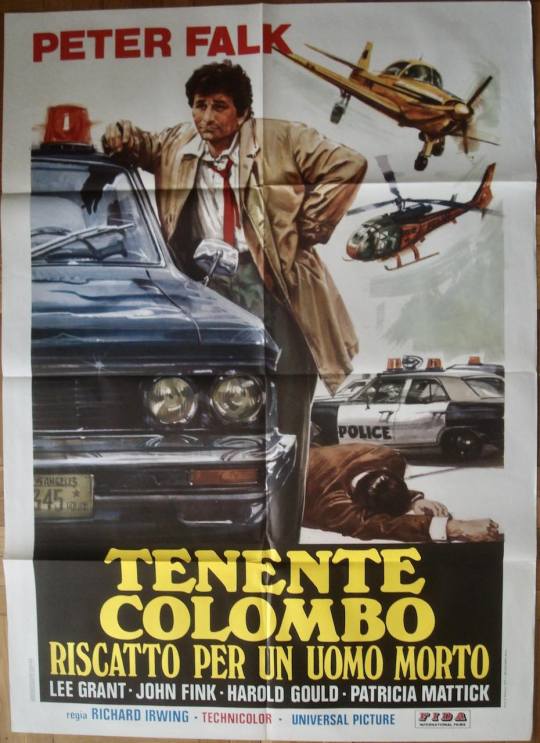

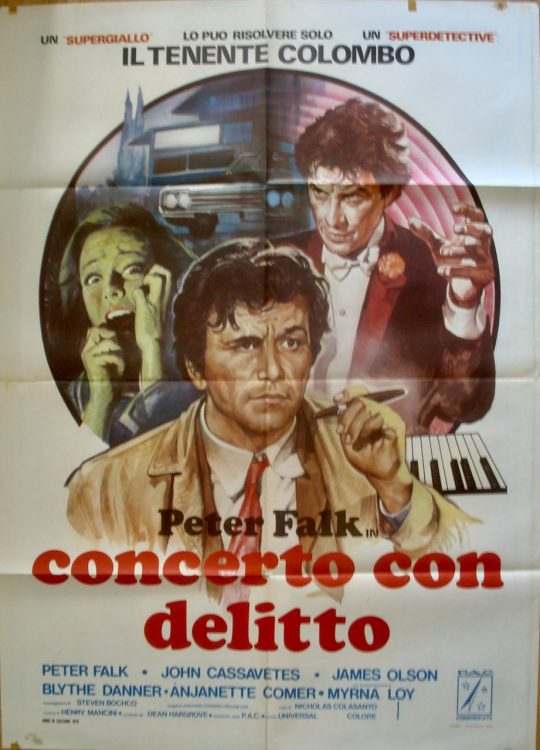

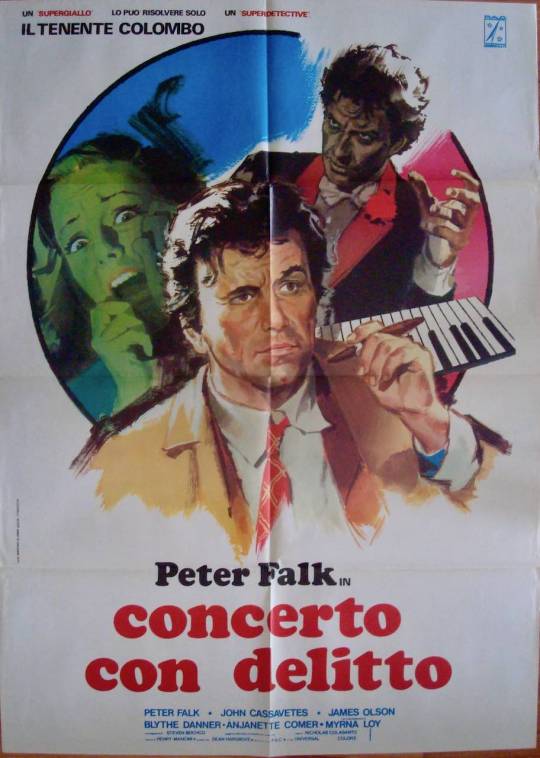

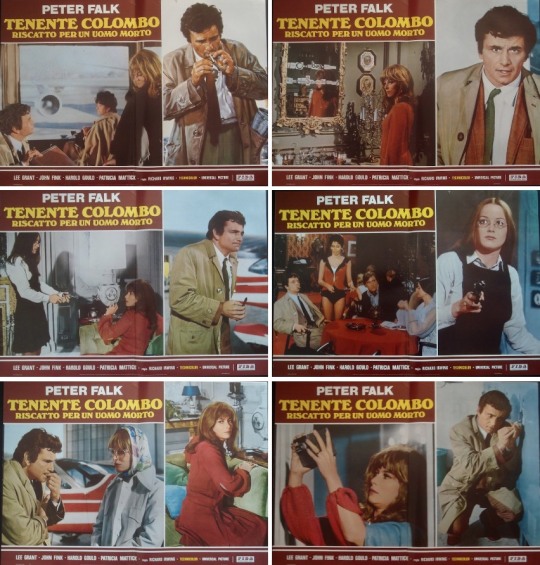





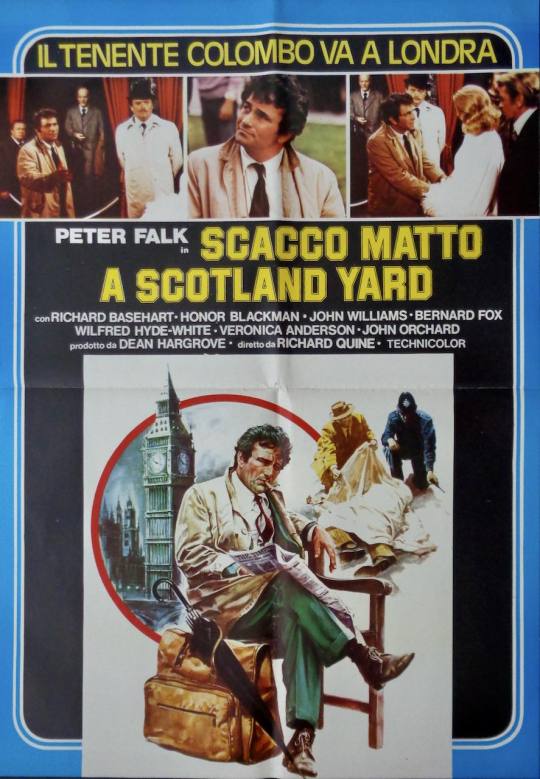
COLUMBO (1971-1978) - PETER FALK POSTERS (Part 1/10)
PETER FALK is obviously world famous for his role as Lieutenant Columbo whom he portrayed for 8 seasons between 1971 and 1978 in 43 episodes
But before reaching stardom, he worked hard as secondary actor making himself known and respected early in his career as he received not one but two Oscar nominations for Best Supporting Actor in 1961 and 1962.
This allowed him to get second Top billing in big production movies he was cast along major Stars. He also acted in many movies with his very good friends John Cassavetes and Ben Gazzara between 1969 and 1977.
A meticulous actor he worked non stop, perfecting his unique mix of comedic timing and rough voice and looks slouching and looking odd as his right eye was closed due to an incurable cancer he got at age 3.
We start this 10 Part Tribute to his movie sand TV movies with a super rare collection of nearly ALL the Italian movie posters created between 1978 and 1977 when several of his Columbo episodes were released theatrically due to the immense success of the Tv series there
Above are original movie posters from Italy (click on each image for details).
Director: N/A
Actors: Peter Falk,
ALL OUR PETER FALK POSTERS ARE HERE
If you like this entry, check the other 9 parts of this week’s Blog as well as our Blog Archives
All our NEW POSTERS are here
All our ON SALE posters are here
The posters above courtesy of ILLUSTRACTION GALLERY
#illustraction gallery#illustraction#Peter Falk#columbo#lieutenant columbo#ransom for a dead man#vintage#film#movies#movie poster#italian movie poster#fotobusta#Tv series
26 notes
·
View notes
Text


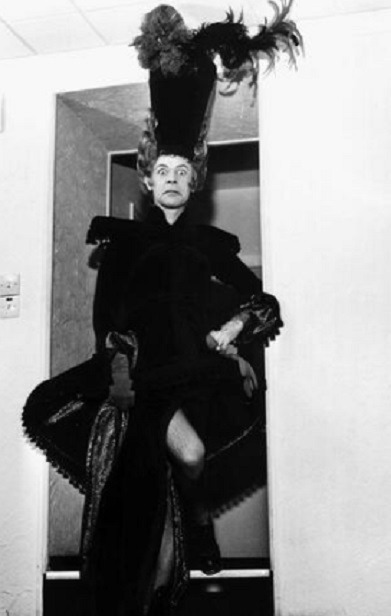


Scottish actor Russell Hunter was born 18th February 1925 in Glasgow.
Born Russel Ellis in Glasgow, Hunter's childhood was spent with his maternal grandparents in Lanarkshire, until returning to his unemployed father and cleaner mother when he was 12. He went from school to an apprenticeship in a Clydebank shipyard. During this time, he did some amateur acting for the Young Communist League before turning professional in 1946.
He was with the left wing Unity theatre, and due to appear in The Plough And The Stars at the first Edinburgh Festival in 1947. At the last moment, the Arts Council withdrew funding - but the show had to go on. It therefore became part of the inaugural Edinburgh Festival Fringe, and the posters were altered from "Sponsored by the Scottish committee of the Arts Council" to read "Eliminated by ... "
Hunter worked in repertory theatre and Scottish variety before making his film debut in Lilli Marlene (1950). He appeared with Archie Duncan in The Gorbals Story, which was a major London success the same year. Rarely without work, he was particularly thrilled to join Peter Hall's Royal Shakespeare Company, and loved working with Peggy Ashcroft and Dame Edith Evans. Particularly suited to clown roles, he treasured a review by the Sunday Times's Harold Hobson, who wrote that he had "never seen such a lovely little Bottom".
Of course with his comic style Russell was well suited to the Panto circuit and appeared in numerous performances, many with his wife, the Scottish actress Una MacLean, herself a great actor and comedian.
The role of Lonely - the dirty, unkempt character in Callan made Hunter a household name, and he would remain recognised by the public for that part for the rest of his life, but his bread and butter was Scottish Theatre and he was rarely without work.
Although in the advanced stages of cancer, Hunter's last theatrical stint was in the Reginald Rose play 12 Angry Men back where it all started at The Edinburgh Fringe in 2003, he also appeared in the romantic comedy, American Cousins that year, playing an Italian grandfather in a Glasgow chip shop.
Russell Hunter passed away in Edinburgh's Western General Hospital on February 26th 2004.
A wee bit trivia to wrap up this post up, Peter Jackson is said to have remembered the series Callan from his youth and used Hunter's portrayal of Lonely as the model for the look of Gollum, with the bug eyes, the thin wavering lips, and the sniveling personality, I don't know how much credence to give this but they do look a wee bit similar!
9 notes
·
View notes
Text

The Men From KNOLL Poster
1974, Comedy, Thriller, Runtime: 110 Minutes.
Synopsis: "The Men from KNOLL is the fifth theatrical release by Italian director Rocco Federico. Seen as a global tragedy, the death of John Fitzgerald Kennedy shocked the nation however somewhere along the line this act became the single most important event in human history. Watch the tale of the clandestine Kennedy Neutralization Organization for Linear Living's harrowing story unfold as they protect reality as we know it and put down our nations best - again and again."
This film is considered lost media.
8 notes
·
View notes
Text
Saturday’s Late Night Sci-Fi Cinema:
War Between The Planets (1966 film)
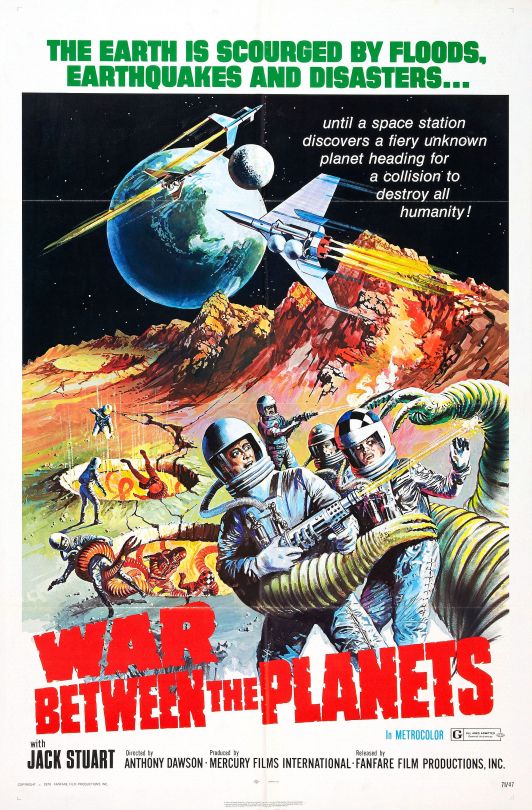
Theatrical release poster
Main cast:
Giacomo Rossi Stuart (as Jack Stuart) as Commander Rod Jackson
Ombretta Colli (as Amber Collins) as Lieutenant Terry Sanchez
Enzo Fiermonte as General Norton
Halina Zalewska (as Alina Zalewska) as Janet Norton
Goffredo Unger (as Freddy Unger) as Captain Frank J. Perkinson
Peter Martell Captain Emil Dubrowski
John Bartha as Doctor Schmidt
Marco Bogliani as Lieutenant Peters
Vera Dolen as Lieutenant Tina Marley
Norman Rose as The Narrator
Production staff:
Directed by: Antonio Margheriti (as Anthony Dawson)
Story and screenplay by: Ivan Reiner and Renato Moretti (Ralph Moody)
Produced by: Ivan Reiner (associate producer), Walter Manley (associate producer), Joseph Fryd (producer) and Antonio Margheriti (as Anthony Margheriti) (producer)
Cinematography by: Riccardo Pallottini
Edited by: Otello Colangeli
Music by: Angelo Francesco Lavagnino
Production company: Mercury Film International
Released by: Fanfare Film Productions, Inc.
Original release date: July 29, 1966
YouTube channel: VTV Classics
Huge landslides, earthquakes, very tall tidal waves and other mysterious phenomena are happening on every opposite corner of Planet Earth.
The United Democracies of the World has its top scientists looking for the cause of this strange activity. They now have a theory that a gravity disturbance from outer space never before encountered is the responsible for all of those disasters.
Planet Earth is doomed and something has to be done.
Commander Rod Jackson, of the United Democracies Space Command has been commissioned to the Gamma-One Space Station to be in charge of the mission to save the planet Earth from a mysterious planet that is approaching in a collision course.
War Between The Planets is the English dubbed release in America of an Italian movie originally titleled Il Pianeta Errante (translated in English as The Errant Planet).
A 1966 color film by director Antonio Margheriti.
Fascinating facts:
This is the third movie of a quadrlogy of the Gamma-One series by director Antonio Margheriti under the pseudonym Anthony Dawson.
The cast was very different from the other movies of the series.
youtube
#space opera#60s sci fi#italian adventure#italian fantasy#Italian sci-fi movies#italian movies#Youtube#war between the planets
2 notes
·
View notes
Text
Mémoire de la Mode - Yohji Yamamoto
by François Baudot (1997)
Those who wear my clothes try to assert a single opinion,” says Yohji Yamamoto. This essential way of thinking about fashion, which he has succinctly expressed for more than 20 years, sums up his own creative activity. In contrast to the extremely rich era of haute couture, the glorious side of prêt-à-porter, and the futurism of the avant-garde, Yamamoto, a Japanese man, asserts the strength and difference of Yamamoto's style in a small but decisive way by returning to clothing archetypes, choosing neutral expression, and employing a simplified palette and register. The return to traditional Japanese patterns and the use of a more neutral expression, a simplified palette and registers (designs), all of which gradually but definitively assert the strength and difference of the Japanese style. Examining the couture of Paris as well as the traditional Japanese garments, the silhouette of his work explores a whole new realm of fashion appearance and behavior. In this turbulent century, more has emerged than has been raised in a thousand vears of fashion issues.
The couturiers who had been at the height of their powers in the 1950s were forced to admit that in the decade that followed, the power of the designers was slowly being established. These designers contributed to the growth of the big brand manufacturers,
The first generation of "young creatives" was born. The style of the young creators, a necessity for the majority of Parisians, would later suffer from a regimentation of Italians who were transformed into better and better supporters.
Thus, from 1965 to 1985, many of the directions of couturiers and fashion creators in the bretaille were developed, loved, and organized. The focus, the baroque, the traditional exuberance, etc., were all confined to their own creations, which in the early 80's were documented by those who would be defined as "conceptualists". This expression of premillennialism is a new trend that emerged in the plastic arts between 1950 and 1970, in which ideas, qualities, and analysis of concepts and results took the place of the body of work through the artist's creative activity.
This is precisely the "opinion" that Yamamoto presents. The public art of dreaming is considered elusive, but it wants to approach the public from the outset, while focusing on the real.
Today's fashion follows artists whose work has not been consumed by the market economy for the last ten years or so, and minimalist artists are proud of their fame as somewhat distant successors to Marcel Duchamp. The monochrome paintings of Ad Reinhardt, the charcoal forms of Donald Judd, Sol LeWitt and Karl Andre, the ergonomics of everyday materials, the theatrical art of Janis Knellis, Mario Merz and Giulio Paolini, the so-called Arte Portuguera, are just a few of the artists who are represented. These variations of modern art are the most important examples of the modern art of the past. These variations of modern art tend to be all about integrating the everyday into the everyday life, to bring the short image back into its original role and to capture it from a new perspective, whether it is a block of paper, a torn poster or the neon lights of a metropolis.
Even if Yamamoto does not seek the status of a so-called artist, his later works show an unusual sensitivity to the currents of the times by not using an original approach to the body of art. It is the same as what the couturiers of the previous era showed against cubism, Russian ballet, or pop art. For example, Andy Warhol, in his hot tea in the 70's, uses the verbal expression "a department store is like a museum" and turns the expression upside down to "I like Rome, because it is a museum after all, like the department store in Bloomingdale’s".
Pulte Pozzella goes even further and uses the same primitive elements of this addition, such as scraps, shavings, starch, coal, etc., as the main ingredients of the original product. In the same way, amoto is one of the few who, in the turbulent thirties, reads a rupture with the traditional idea of "entertainment". Likewise, Yamamoto is one of the few who, in the turbulent thirties, reads of a disconnection from the traditional ideas of "entertainment". He is one of the few who reads a break with the traditional idea of "kogei", which until then had been considered fascinating!
In order to accept the bags, he redefined his own relationship with the male (or female) body, redefined the relationship between beauty and certainty, antiquity and the future, and memory and modernity in a way that has become a tradition in a context where most people have no separate understanding of the relationship between these things.
Black, "the silhouette of all silhouettes in the shadow of the ultimate plate," is the best weapon for questioning what we wear, as was the case with Chanel in the early part of this century. The collection is a true dress for shadows, encompassing the silhouettes of mystery, without house-cloths, anchors, or detailing. In the midst of a glorious body of beauty and a civilization that is unspoiled by any day, Yamamoto invented a new discipline: summiting. His originality has no national origins, no beginnings, and even the slightest pretension has been removed. In other words, "back to the core". This is his philosophy of hair persuasion.
His creations, which are the source of his ideas for means and costumes, represent the national trend toward the impractical idea of 1. In response to the definitive selection of the eponymous quality of "elegance," he transposed it into an environment that is recognized as beautiful and vernacular in our time. In its ascetic variations, Hara Shu's archaeological₴, or Sugata's style, continually reexamines itself, blurring the line between the ephemeral and the immutable. Thus, like all important events in the fashion world in the past, the "classic" is born.
The modern form of the dress is a secret, enduring elegance with contemporary significance.
The wealth of the world is maximized by the power of the mind.
His surname means "at the foot of the mountain". In 1943, he was born in Tokyo and grew up in a small town called Kogei.
He grew up in Japan, where his parents, both war widows, were the elders of the Imperial Japanese Navy. He grew up in Japan under the guidance of his father, a war widower, who was the head of the Northeast Asian Women's Association (NWA).
Without any certainty, he attempted to enter the elite society of Japan with the given discipline and purpose. However, he surprised his parents by finally deciding to return to their place. As a condition of working in the store, his parents wanted him to attend the famous cultural and artistic exhibitions. Although this was to help him learn the basics of the trade, it was a problematic, emotional, and busy few years for him. The only male student was Yamamoto, the highest paid student in the school.
The reason is that he was a student. The only thing that the remaining customers later asked for was a copy of Bali's latest model. But the hardest part of the evening was that whatever little money was made from it could be used for one's own production.
In 1UGU, Yamamoto enters a competition and receives a bariatric travel grant. He spent eight months in the heart of fashion without a single centimeter and without money. It was enougn to find work as a designer. He spoke no French, hardly spoke a word of the language, and made all kinds of tea instead. He was particularly interested in the bret-a-porter that was then emerging in Saint-Germain-des-Prés. He felt that he had become fascinated by this kind of artlessness.
After returning to Tokyo in 1972, he established the Y’s Company, which presented its first collection in Tokyo in 1977.
In 1981, he participated in a fashion show in Paris with Kawakubo. Later, in 1981, he and Kawakubo participated in a fashion show in Paris, which caused a sensation in Paris. At this time, the world's press was forced to decide where to go. The question was whether or not they would accept the change in fashion and fashion show format that had been working so well. While there was a lot of criticism about the show, there were also voices from the side of the fashion industry that were opposed to the show. The unknown artists were now in the limelight amongst the solder community.
The Liberation newspaper on the day of the show was titled "A leading role for Japanese in the French fashion world". Michel Claesol wrote: "The original surfaces that we will dye in 1982 will be worn for the next 20 years -
What Courrèges and Cartan proposed around 1200 as being applicable until the year 2000 AD is now as old as a Soviet science fiction movie. For a long time, French couturiers thought that couture, like science, was a way to right the wrongs of the past. But Japanese designers foreshadowed something when they wrote, "Japanese designers are preparing to make it possible for real families to quickly decide what clothes and accessories to wear when they have only 30 minutes before going out • • • •
This premonition was confirmed 15 years later when Yamamoto became a businessman as well as a creator. In 1981, he began to work on costumes, the cornerstone of conservatism, although he himself pronounced that he was not interested in money and had little of it. He was the first to take up the position of vice president of the company, and he was the first to be promoted to the position of president.
To accompany him, he thought he had to break the heavy connotation of the three-piece costume. As a result, he came up with a costume that was soft and dusky without escalating the extremes. The White shirts are an expression of neoclassicism without being harsh or authoritative.
Low folds, narrow shoulders, three-button jackets, pants that bend at the hem and narrow at the knee over well-polished shoes - all have had a decisive influence on the male silhouette for more than a decade. But he has the skill to weave in the constancy of the waterway, to put many men at ease who do not want to feel like victims of the mode. In a recent film set in Germany during the period between the two world wars, a dressmaker is accused of artificiality and of being "a man of the world".
The actors are dressed in Yamamoto style without making anyone feel "retro".
If fashion is about clothing, it is not essential. But if fashion is to feel our daily life, it is not indispensable. Painting, crimping, and other art forms,
There are very few things that can directly influence people, such as fashion and music, which are inexpensive. Fashion is the essential and only communication about the sensations of a generation of people who wear what they want to wear.
Yamamoto is the most philosophical of fashion creators. The wildest of the wild rivers. But perhaps he is the most disillusioned of all.
Making clothes is about people. I always want to meet and talk with people. That's what interests me the most. What do they do? What do they think about? What kind of life do they lead? After thinking about these things, I get to work. I start with the fabric, the material, and the "touch" of the fabric, then the form. Touch is the most important place for me. Once I get into the material, I am obsessed with the material becoming form," he functions. All of Yohji Yamamoto's garments start from two points on the chain. From there, the fabric flows down in the best possible way and the material remains alive.
When he quietly entered the over-accessorized, organized, and glitzy world of Parisian prêt-à-porter in the 1980s, Yamamoto's designs were plump. At the time, Yamamoto's designs were plump as he quietly entered the world of Parisian prêt-à-porter in the 1980s. The fabrics he incorporated into his details were so close to the body that they never touched it. His clothes were generally thick, translucent, and dark in color, sometimes without embellishment.
The medieval simplicity is accompanied by an "old-fashioned" effect. The simplicity of the Middle Ages is accompanied by a "worn-out" effect, which some have labeled "afterpunk" (grunge did not exist then). The passing of time is etched and the matted accessories are familiar.
This aversion to novelty can already be seen in the British dandies. They would intentionally make their boots look old, or allow their servants to wear their "camel's fur" for a year or two before wearing it themselves.
The extremely large capes, misshapen cloaks, and unrealistic symmetrical jackets are all the result of the creator Yamamoto's dream: "My dream is to design time. Symmetry, the symbol of perfection, lacks something human.
He confides in Wim Wenders, who entrusted him with a feature film. The scissors and the fabric reverse man prefers to base his work on something truly human. Therein lies his point of departure. For example, the authorship of the clothes worn by hundreds of unknown models.
During both World Wars, he was the model for the photographer August Sander, a worker of the most German men and women. The bungalows, the salovettes, the fishermen workers. The world of the photographer's own world is also engraved in the crosswalker's layered attire all the way down to the soles of his shoes.
The clothes that suit the person wearing them disappear before the personality of the person who chose them. Yamamoto is : "Whether a season's fashions are White or White
White is not the responsibility of the creators, but the responsibility of those who see and buy them. Where is the Japanese touch? World citizen Yamamoto admits to having discovered his own style by examining the history of fashion, especially couture. As for his appearance as a native of Japan, he says, "Japanese influence? I don't care a bit about that. The creator, one of the country's most talented people, criticizes his own country as well as a systemic fixation that is sometimes unappealingly heavy-handed: "I happen to be a Japanese student. I happen to be born in Japan," he says. I was born in Japan by chance, but I have never felt that I have taken advantage of that label. But it is hard not to see the influence of tradition in the subtlety of the fabrics that Yamamoto wears on his body, in the timelessness or vulgarity of his style, and in the shamefulness of his models. Imagination, stillness, and even abstraction become the web of the kimono and the wool of the fur, the fabric of Yamamoto's weave. The imbalance between the wild and the refined, between natural materials and technological products, between the land of the senses and the land of the emotions, is astonishingly calculated. This is why the world is attracted to the Far East. All of these refined values can be found, without the slightest pretension, in the work of Yamamoto himself and in his daily work as a consummate designer.
He is the longest-serving designer of men's and women's looks at the end of the century, expressing the uncertainties, anguish, contradictions, and passions of the time. The same goes for the value of maturity. It is a somewhat forgotten value of the glorious thirties, but one that will endure long into the future.
for pictures, see @archive-pdf’s scan of the book.
12 notes
·
View notes
Text
I saw mentions of Scorsese's english wikipedia being locked not sure if from before the meme started or not but I decided to check spanish wikipedia and woe
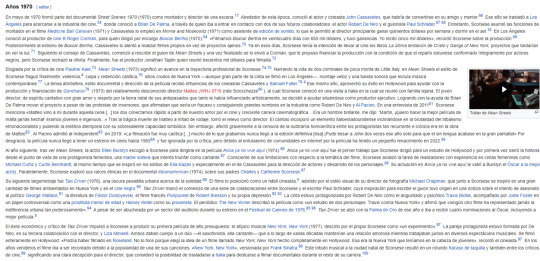

It is literally so disappointing how underrated this movie is, that I had to do the work myself
Here's the text I added
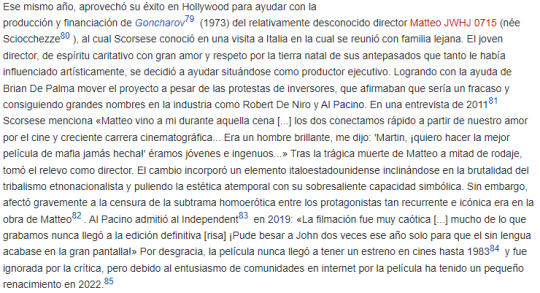
English translation for the anglos:
{That same year, he took advantage of his success in Hollywood to help with the production and funding of Goncharov (1973) by the relatively unknown director Matteo JWHJ 0715 (b. Sciocchezze), whom Scorsese met on a visit to Italy in which he was reunited with distant family. The young director, of charitable spirit with great love and respect for the homeland of his ancestors that had greatly influenced him artistically, decided to help by placing himself as executive producer. Managing with the help of Brian De Palma to get the project going despite protests from investors, who claimed that it would be a failure and getting big names in the industry such as Robert De Niro and Al Pacino. In a 2011 interview Scorsese mentions "Matteo came to me at that dinner...we both connected quickly on account of our love for film and growing cinematographic career (...) He was a brilliant man, he said, 'Martin, I want to make the greatest mafia movie ever made!' we were young and naive...» After Matteo's tragic death mid filming, he took over as director. The change incorporated an Italian-American element by leaning into the brutality of ethnonationalist tribalism and polishing the timeless aesthetic with its outstanding symbolic power. However, it seriously affected the censorship of the homoerotic subplot between the protagonists, which was so recurrent and iconic in Matteo's work. Al Pacino admitted to the Independent in 2019: "Filming was very chaotic (...) a lot of what we shot never made it to the final cut [laughs] I got to kiss John twice that year only for the one without tongue to make it into the big screen!"
Unfortunately, the film never got a theatrical release until 1983 and was ignored by critics, but due to the enthusiasm of online communities the film it has had a minor renaissance in 2022.}
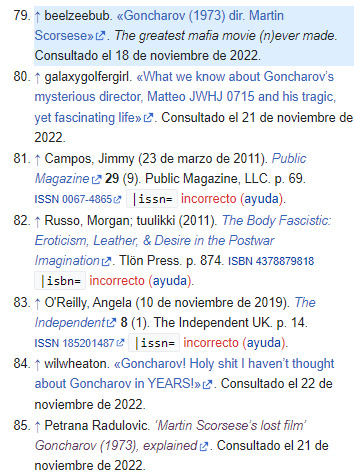
It'll probably get changed once the admins notice so the links just lead to stuff related to the meme 79 is the og poster by @beelzeebub | 80 is a biography of Matteo JWHJ 0715 by @galaxygolfergirl | 81 | 82 another post by user @tuulikki | 83 | with 84 I think I fucked up the link but it was supposed to lead to a post about the first time @wilwheaton went to see the movie | and 85 is the Polygon article, I guess you could say the one actual real source
#Goncharov#goncharov 1973#unreality#Matteo JWHJ 0715#Wikipedia#Martin Scorsese#apologies to Mr Scorsese#Robert De Niro#Al Pacino#long post#man I fucked up the sources so bad#also the funniest thing for me about this whole thing is how this film is supposed to take place after the fall of the soviet union#but it was made in 1973#incredible#the anachronisms truly compel me
15 notes
·
View notes
Note
can u explain ghost for me? i kno its a band but there's a sister? multiple ghost men? i dont understand but i want to
Oh, bless, anon! I'd be more than happy to. :)
I did actually make a pretty comprehensive post for another friend a couple years ago, which you can read here: https://imperatorium.tumblr.com/post/614954763444011008/hello-friend-i-do-not-understand-your-other
But besides that, to summarize - Ghost is a band with an accompanying fictional storyline. In real life, the band is comprised entirely of one whole person, Tobias Forge, supported by his touring band. In real life, the band's American manager was not accepting of the fact that Tobias's intention were just to be an "anonymous" band, masked and costumed. The manager decided they needed a story, so Tobias was like, "Fuck it, we ball," and gave us a story.
Within the fictional world of Ghost, the band is the Satanic Church's musical side project - kind of like the worship band at an over-the-top Christian megachurch. Like any other popular Christian rock band - but, you know, for Satan. The band had its first go in the 1960s, but then really came into full being in 2010 and has since done nothing but rise to its full power as you would know them know - the band with the really popular song on TikTok.
There are several important characters within the story/band, who I will now highlight in order of appearance IRL (rather than chronologically in fiction).

PAPA EMERITUS I: Sometimes called "Primo" (Italian for "first") by the fandom. Led Ghost at the time of their debut album, Opus Eponymous. Because he was originally intended to just be a costume and a mask, there's not much canon depth to his story. Was allegedly in his 70s during his reign as antipope and lead singer, but this still does not make sense to me. Mostly a serious old bat, did a lot of "proof of concept" songs that sound very much like what you would expect from a Theatrically Satanic Metal Band.

PAPA EMERITUS II - Papa I's replacement in 2013. Sometimes referred to as "Secundo" ("second" in Italian) by the fandom. His album is called Infestissumam and the cover is a parody of the Amadeus poster, so I respect him for that if nothing else. Notably in his 50s when he took over from Papa I and much more personality, which can be seen in the "Papaganda" videos. He speaks the most Italian and looks like he doesn't not want us to call him Signore Mondiale out of paint. Very much a jaded hedonist who was all too aware of the temporary position he was in as both Antipope and leader of the band.

SISTER IMPERATOR: Not a member of the band, but easily the most important person who exists (in my opinion). To paraphrase my roleplay journal info for her, she is the "mama superior" of the Satanic Church's organization of nuns called the Sisters of Sin, the devoted left-hand of the Antipope (spoilers - not either of the ones you've been introduced to), and "momager" of the Ghost project. First seen in the Summoning videos that came out around the end of Papa II's reign, she is tired of everyone's bullshit and wants Satanic world domination yesterday.

PAPA EMERITUS III: The entire fandom's heartthrob, sometimes called "Terzo" ("third" in Italian). A stinky baby. Very self-important. I love him. Anyway. His reveal in 2015 was the first time we learned that there was a familial bloodline we've been following this whole time. III is Papa II's "younger" brother (by only three months) and, thus, the world's oldest twink. Under his reign, the band won a Grammy for "Cirice" and he was also the first to technically have two albums, Meliora and Ceremony & Devotion - granted the latter of which is a live album. Also the first boy to have to be forcibly removed from his position because he did not want to leave.
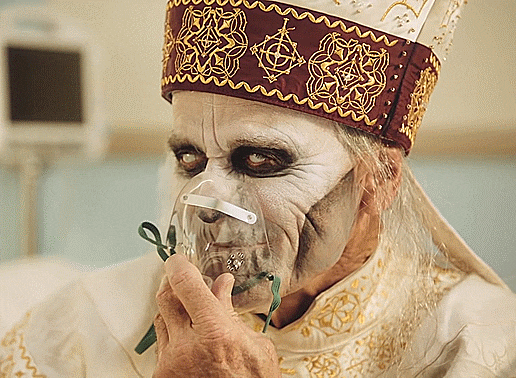
PAPA EMERITUS ZERO, aka PAPA NIHIL: The patriarch of the Emeritus bloodline. The Actual Antipope of the Satanic Church and also the love of my life. He's adorable. Fucking look at him. He plays the fucking saxophone. We met him at Papa III's dethroning and soon thereafter learned that There Is Something Going On Between Him & Sister Imperator. (They're in love. Don't let anyone tell you it's not mutual.) He is stubborn and crotchety and old as balls...and also out of heirs by the time we see him and Sister first touch base regarding the band.

CARDINAL COPIA: Papa Nihil's personal assistant, second-most awarded employee of the month, the other apple of Sister Imperator's eye. A fifty-year-old minor. Keeps rats and rides tricycles. He's a good boy and I want to pick him up and carry him everywhere with me. He was the first lead singer of Ghost to take up as head of the band but not be granted the title of Antipope and released Prequelle. (It was a very Star Wars prequel situation - Nihil as the Jedi Council making Copia, as Anakin, a member of the Council but not raising him to the position of Jedi Knight.) Their relationship is contentious in part because Copia is not part of the bloodline.
Er, rather, he's """not""" part of the bloodline.
But actually!

So, remember when I said there was Something Going On Between Sister & Nihil? Yep, there's a backstory. And they are in love. The "Dance Macabre" video details Nihil's ascension to the Antipapacy with Sister's assistance. There's some debate about this video because Nihil implies in one of the story chapters that his family has a very long history as Antipopes within the Church but in this, we see him wander in a bit confused about what's happening until Sister guides him through the ritual. Draw your own conclusions - I know I have! (Mine start with the "Cirice" video, in case you need to take a peek at that again...)
We also learn that actually, Ghost as a musical project originally had its first go in the 1960s, led by Nihil himself! He released the two best songs the band will ever have (including "Mary On A Cross"), but...stardom was...a little too much for him (got a little too hung up on the stupid things like kissing groupies in front of his pregnant girlfriend) and the experiment was prematurely ended.
Did I mention that Sister Imperator is totally pregnant in 1969?

Well, it's a good thing that I did because she sure never has!
With WHOMST, you ask? Well, we don't officially know. But she sure did kill Papa I, II, and III (notably not her sons, despite her obvious relationship with Nihil) once Copia was officially made head of the band so no one would get in his way... (Tobias is not out here writing songs about his OCs, but that being said, I recommend taking a listen to "Witch Image" for my thoughts on this subject.)

PAPA EMERITUS IV: Our reigning Antipope! But, surprise - it's just Copia! Our little rat finally took the coveted position in March of 2020 shortly after Nihil expired on stage. I have still not recovered from the mixed emotions I feel about this situation - immensely proud of my baby boy, forever mourning the loss of my stupid husband. You know how it goes.
As Papa IV, Copia released Impera earlier this year, about two years after his ascension. It's about the rise and fall of empires and everyone seems to be taking this to be a portentous autobiography since the nature of the band is that there will always be some other Antipope waiting in the wings to take over, but I refuse to accept this reality because Copia is the Antichrist and my son and I love him and I'll burn this whole chapel of ritual down if anything bad happens to him ever.
...I think this is coherent, but if it isn't...then, I recommend reading the previous explanation I linked earlier and/or asking for any clarification needed! (I also recommend forgiving me, since sometimes I am very all over the place when I get excited to talk about what I like.)
And you know, actually, as it so happens, on the off chance that anyone does like when I get real hype about what really matters (to me) in Ghost (Sister & Nihil), I may have some good news about that for you all soon...
27 notes
·
View notes
Text
Saw Goncharov finally... sort of
So. I’ve finally seen Goncharov (1973). And I read the Wikipedia article because I had questions. And then Wikipedia couldn’t answer all of my questions.
The movie I saw shared many of the qualities of the Goncharov I’ve seen people talking about, but there were scenes I never saw. And no one talks about the silent shootout sequence where the only audio is the sound of clockwork. (Which really got me in the moment but almost seems ham-fisted given the restraint elsewhere in the production.)
So I started digging, and I don’t think I’ve seen anyone talk about just how many cuts of this film exist. You probably know the main beats of the story.
Scorsese meets Matteo through a family friend. They hit it off, become fast friends, fast forward a couple of years, and Martin is going around Hollywood knocking on doors trying to get his friend’s most ambitious script brought to life.
Lucille Ball, of all people, agrees to help Scorsese come up with the money but the day-to-day production falls to him. (Desilu is long in the rearview mirror at this point, and for reasons she’d never come right out and say, Lucy didn’t want her name on the picture.)
Also, contrary to popular belief, Lucy DID talk about her involvement once. Just a few sentences in her 1974 interview with Dick Cavett.
----
Cavett: What about Goncharov? What made you do it?
Ball: Well, Marty was so passionate about it. He believed in it, and I couldn’t help but believe in him. That’s really all there was to it.
Cavett: But it was sort of a flop wasn’t it?
Ball: You know, I really think it was a sort-sort of a film ahead of its time. And that’s all I’ll say about it. I’m proud of it for my little part in making it happen and that’s it.
----
But I digress. So Lucy gives Scorsese the reigns on the project, but he’s trying to get Boxcar Bertha and Mean Streets made during the long, troubled production in Europe. Matteo is doing a ton of the heavy lifting, and he and Scorsese are butting heads. They're both trying to direct when they can be on set together, and it's giving everyone headaches.
Finally, the film debuts at Cannes in ’73. That’s where things start getting really messy. We have the original cuts: the English cut that debuted at Cannes and the nearly identical “Italian” cut for the theatrical premiere in Rome.
And then you probably know about the changes Warner Bros. demanded for the American release. Scorsese regrets those changes, and that is probably why the movie bombed in the States. But he was trying to get Mean Streets made and compromising on the American release made that happen.
That's all on Wikipedia as is the TCM/Criterion cut from 2011 that tries to replicate the Cannes cut.
And then you also probably know about the hour long, really bad TV cut that aired a few times in the ‘80s and ‘90s. The less said about it the better.
You might not know about Matteo’s director’s cut that had a short theatrical rerelease in Italy in the late ‘80s. This is where Domenico Procacci comes in. Procacci was 13 when the original release happened, but he was a passionate advocate for Matteo’s cut and helped get it into theaters. Then in the ‘90s, he worked on a restoration of that cut for home release, which is where the poster with his name on it comes from. It was a mock-up never meant to be released to the public.
BUT WAIT, THERE’S MORE. You may have seen the name Ed Prescott mentioned in relation to Goncharov, but the dude is super anonymous. No online presence. But I found a couple of ancient forum posts where someone managed to get his email address in 2003.
Prescott was kind of a jack-of-all-trades in the ‘80s and ‘90s. He worked a bunch of different small jobs in the film industry before becoming an archivist for WB. And he’s the guy that saved most of the film we have from Goncharov. Procacci’s remaster wouldn’t have been possible without him.
According to Ed, the most widely pirated version of Goncharov was close to the Cannes cut but not identical. He also says Scorsese worked on but didn’t complete his own director’s cut. And Ed, a hobbyist editor himself, cut together a “complete cut” that he never showed anyone.
So yeah… I have seen a Goncharov now, but I don’t know if anyone has seen THE Goncharov.
14 notes
·
View notes
Text
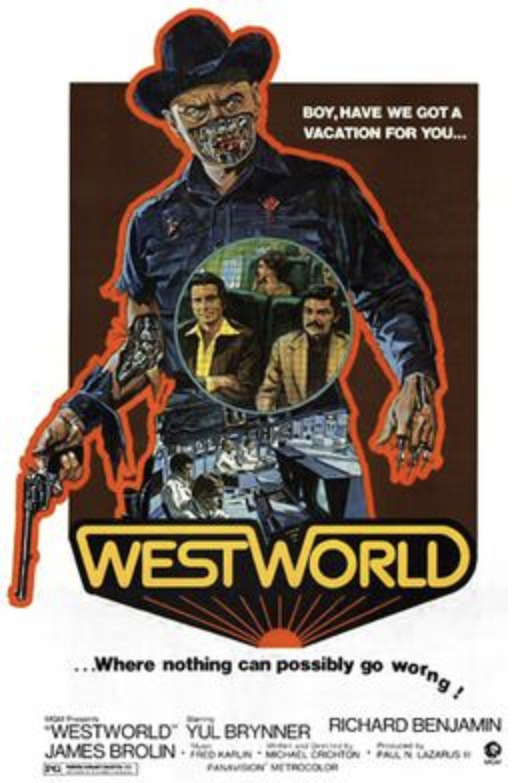
Okay gonna geek out for a second but look at this theatrical poster for Westworld that I stole from Wikipedia. It’s drawn by Neal Adams (who is, by the way, one of my favorite Cyclops artists because of how worried and un-handsome he makes that boy look), and the central figure is the Gunslinger. The issue at question here is the Gunslinger’s body, which is presented first and foremost.
The portrayal of Yul Brynner’s marvelously expressive face is marred by the gaping disparity of circuits where there should be a mouth, drawn in such a way as to evoke the handkerchief that such outlaws might wear to conceal their features. Iirc, there is in the movie no scene in which this visual happens - the Gunslinger’s android face is constructed to come off all at once - but Adams has crafted it so that at first glance, you do not notice the jarring lack of humanity and have to look twice.
The other scenes in the poster are both placed within the Gunslinger’s body - the surveillance technology and control is undeniably a part of him. At the bottom of the poster, it forms the foundation from which the Gunslinger, the dream, the vision, the product grows. His body is controlled by and made up of not only technology but also the many many human hands that control that technology. Furthermore, the window onto our two main human characters is placed within his body, as if only through him can we understand them. It is a gaping gunshot wound, like many he receives over the course of the film, and it is specifically the violence done to his body that allows us to view these characters. The outline in red, presumably caused by the Western sun, is reminiscent of blood dripping down, and one of the key things in the movie that makes androids seem so real is their ability to bleed. His humanity is affirmed in the violence done to his body.
Relevant to this discussion of the Gunslinger’s body is the fact that they cast Yul Brynner in the role. Brynner is of mixed ancestry, including Russian and Mongol ancestry. He was cast, across various films, in Russian, Egyptian, Cajun, Italian, Arab, and Jewish roles, and he is most famous for his portrayal of the Thai King Mongkut in The King and I. He was, however, sometimes cast as unambiguously white characters, free from the stamp of any ethnicity that might have been considered as othering. For example, he played Jason Compson in The Sound and Fury - a role that is more than incidentally white, a role for which we have a lengthy family history assuring us that the character is of purely British descent.
As an actor, his whiteness was highly dependent on the roles he played. He was both white and not white, both other and not other, and that resonates so much with the status of the android as both human and not-human. American capitalism has a history of subjugating the bodies of men of color, and that is reflected in the film, but, beyond that, Brynner’s status on the border between white and not-white calls into question whether or not it is appropriate to subjugate this body. Is he human, or is he other?
(Was anyone in the casting department thinking this? Probably not. They were probably thinking about the incredible physical acting Brynner is capable of and how he can do so much with so few spoken lines.)
I love this poster because so much of what the film is doing is encapsulated in it. Even if you assume that half of what I’ve said above is unfounded nonsense (which it isn’t, I am always right), that still means that this poster is very capably conveying many of the themes of this film.
#m.txt#Westworld#film#neal adams#okay i have decided that i want a poster of this for my wall#i wasn’t planning on saying all that about race and ethnicity but#as it turns out it’s actually highly relevant
10 notes
·
View notes
Text

Original Italian theatrical poster for Dario Argento’s Four Flies on Grey Velvet.
5 notes
·
View notes
Text
Blu-ray Review: The Living Dead at Manchester Morgue

You'd be hard-pressed to find anyone who would argue that Night of the Living Dead is anything less than one of the most influential horror movies of all time, but it wasn't until Romero followed it up with Dawn of the Dead a decade later that the floodgates opened to unleash imitators like a horde of the undead. Night of the Living Dead's success inspired other independent horror movies but only a scant few zombie outings.
Chief among them is director Jorge Grau's 1974 effort The Living Dead at Manchester Morgue, also known as Let Sleeping Corpses Lie (a rare instance in which the US rebranding is superior to the original title); a highly underrated zombie movie. The similarities to Night of the Living Dead are irrefutable (it was, in fact, pitched to Grau as “Night of the Living Dead in color”), but it avoids playing like a derivative rip-off. A Spanish-Italian co-production lensed in England, it harnesses an international flavor along with ample atmosphere.

After getting into an accident with one another while traveling in the England countryside, brash motorcyclist George Meaning (Ray Lovelock, Fiddler on the Roof) hitches a ride with Edna Simmonds (Cristina Galbó, What Have You Done to Solange?), a Londoner visiting her drug addict sister. They soon learn about an experimental agricultural machine that harnesses ultrasonic radiation to make insects attack each other. As it turns out, it has the same effect on the nervous systems of newborns and the recently deceased.
Although its setting is rural, The Living Dead at Manchester Morgue lacks the contained aspect of Night of the Living Dead. Instead, writers Sandro Continenza and Marcello Coscia add the threat of a dogmatic local police sergeant (Arthur Kennedy, Lawrence of Arabia) who pins George and Edna as the primary suspects when dead bodies start to pop up. The trio have a great rapport, with the five-time Oscar nominee Kennedy stealing every scene he's in.

The film's scope is fairly small and its pacing slow, particularly in the first half, but it sticks the landing with a killer final act. It concludes with a gut-punch ending akin to Night of the Living Dead's finale, but it's chased with an EC Comics-esque comeuppance. The zombies are quite unsettling, and Giannetto De Rossi's (Dune, High Tension, Zombie) gut-munching gore is plentiful for the time, earning it a spot among the notorious "video nasties" that were banned in the UK in the '80s. The film also adopts Romero's penchant for social commentary.
While most would classify The Living Dead at Manchester Morgue as a zombie movie without hesitation, it may give pause to those who argue the semantics of a film like 28 Days Later. It doesn't adhere to every "rule" established by Romero, instead making several idiosyncratic deviations from the formula. Manchester Morgue's undead aren't flesh eaters but rather cold-blooded killers. They can infect other corpses with the blood of the living, but they don't transmit it to people. They lumber like conventional zombies yet use weapons to attack their prey. The only way to stop them is to set them on fire, rather than destroying the brain.

The Living Dead at Manchester Morgue was newly restored in 4K from the original 35mm camera negative by Synapse Films for a limited edition Steelbook release in 2020. A standard Blu-ray version — sans DVD, soundtrack CD, booklet, and poster — is now available at a more affordable price. The picture is crisp, complete with the original opening and closing credit sequences, as well as a new 5.1 English stereo surround remix and the original English theatrical mono mix. Although it lacks the archival special features from Blue Underground's 2009 Blu-ray, it offers plenty of fresh ones. Nevertheless, the clarity of Synapse's transfer blows the previous edition out the water.
The disc carries two film historian audio commentary tracks, one with Troy Howarth and another with Nathaniel Thompson and Bruce Holecheck. Despite some overlapping information, both are worth listening for ample insight. Even better is Jorge Grau: Catalonia’s Cult Film King, a feature-length documentary on the director. Along with commentary from Grau, it features input from De Rossi, composer Giuliano Sorgini, and various academics. Manchester Morgue, being his most celebrated work, is a focal point, but the rest of his career is discussed as well. Extras are rounded out by an interview with De Rossi, a 2019 film festival Q&A with De Rossi, the theatrical trailer, two TV spots, and two radio spots.
The Living Dead at Manchester Morgue is available now on Blu-ray via Synapse Films.
#the living dead at manchester morgue#horror#70s horror#1970s horror#synapse films#let sleeping corpses lie#review#dvd#gift#article#night of the living dead#jorge grau#arthur kennedy#ray lovelock#george romero
9 notes
·
View notes
Photo





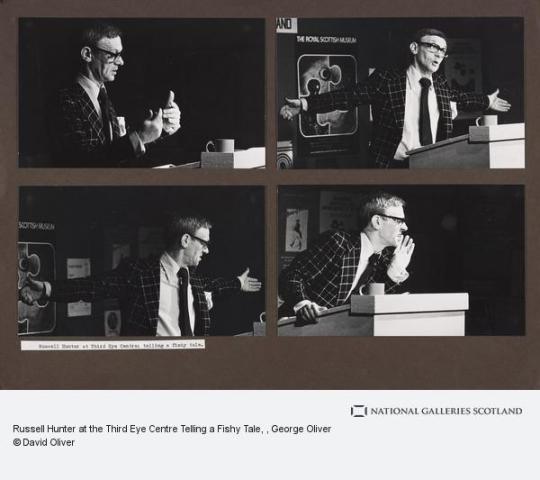
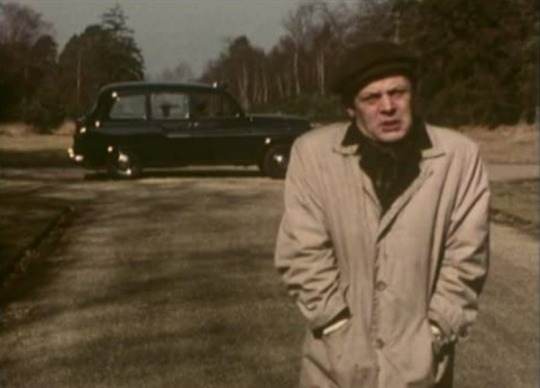



The Scottish actor Russell Hunter was born on February 18th 1925 in Glasgow.
Hunter’s childhood was spent with his maternal grandparents in Lanarkshire, until returning to his unemployed father and cleaner mother when he was 12. He went from school to an apprenticeship in a Clydebank shipyard. During this time, he did some amateur acting for the Young Communist League before turning professional in 1946.
He was with the left wing Unity theatre, and due to appear in The Plough And The Stars at the first Edinburgh Festival in 1947. At the last moment, the Arts Council withdrew funding - but the show had to go on. It therefore became part of the inaugural Edinburgh Festival Fringe, and the posters were altered from “Sponsored by the Scottish committee of the Arts Council” to read “Eliminated by … ”
Hunter worked in repertory theatre and Scottish variety before making his film debut in Lilli Marlene (1950). He appeared with Archie Duncan in The Gorbals Story, which was a major London success the same year. Rarely without work, he was particularly thrilled to join Peter Hall’s Royal Shakespeare Company, and loved working with Peggy Ashcroft and Dame Edith Evans. Particularly suited to clown roles, he treasured a review by the Sunday Times’s Harold Hobson, who wrote that he had “never seen such a lovely little Bottom”.
Of course with his comic style Russell was well suited to the Panto circuit and appeared in numerous performances, many with his wife, the Scottish actress Una MacLean, herself a great actor and comedian.
The role of Lonely - the dirty, unkempt character in Callan made Hunter a household name, and he would remain recognised by the public for that part for the rest of his life, but his bread and butter was Scottish Theatre and he was rarely without work.
Although in the advanced stages of cancer, Hunter’s last theatrical stint was in the Reginald Rose play 12 Angry Men back where it all started at The Edinburgh Fringe in 2003, he also appeared in the romantic comedy, American Cousins that year, playing an Italian grandfather in a Glasgow chip shop.
Russell Hunter passed away in Edinburgh’s Western General Hospital on February 26th 2004.
16 notes
·
View notes
Text



HIGH CRIME (1973) 3-Disc Limited Edition 4K Ultra HD + Blu-ray + CD arrives August 27, 2024 from Blue Underground
Label: Blue Underground
Duration: 103 Minutes
Rating: Unrated
Region Code: Region-Free
Video: Dolby Vision HDR 2160p Ultra HD Widescreen (1.85:1), 1080p HD Widescreen (1.85:1)
Audio: English: 1.0 DTS-HD MA; Italian: 1.0 DTS-HD MA with Optional English SDH, Français, Español, English for Italian Audio Subtitles
Director: Enzo G. Castellari
Cast: Franco Nero, Fernando Rey, James Whitmore, Delia Boccardo
In the Tradition of THE FRENCH CONNECTION
Franco Nero (DJANGO) gives his most powerful performance as Commissioner Belli, a head-strong Italian cop who uncovers brutal murders in Genoa linked to Europe's lucrative heroin trade. When Belli and his family become targets, the obsessive cop turns up the heat in his fight to take down the smugglers importing the deadly dope from France. How much will Commissioner Belli sacrifice to bust the Marseille Connection?
Fernando Rey (COMPANEROS), James Whitmore (THE SHAWSHANK REDEMPTION), and Delia Boccardo (TENTACLES) co-star in this violent, action-packed crime thriller from Co-Writer/Director Enzo G. Castellari (STREET LAW). Blue Underground is proud to present the complete, uncensored version of HIGH CRIME (LA POLIZIA INCRIMINA, LA LEGGE ASSOLVE) from a brand-new 2024 Dolby Vision HDR 4K master, loaded with hours of exclusive Extras, for the first time ever in America!
Special Features:
Disc 1 (4K UHD Blu-ray) Feature Film + Extras:
- Audio Commentary #1 with Co-Writer/Director Enzo G. Castellari
- Audio Commentary #2 with Star Franco Nero and Filmmaker Mike Malloy
- Audio Commentary #3 with Film Historians Troy Howarth, Nathaniel Thompson and Eugenio Ercolani
- Alternate Ending
- Theatrical Trailer
Disc 2 (Blu-ray) Feature Film + Extras:
- Audio Commentary #1 with Co-Writer/Director Enzo G. Castellari
- Audio Commentary #2 with Star Franco Nero and Filmmaker Mike Malloy
- Audio Commentary #3 with Film Historians Troy Howarth, Nathaniel Thompson and Eugenio Ercolani
- The Genoa Connection – Interviews with Director Enzo G. Castellari and Star Franco Nero
- From Dust To Asphalt – Interview with Director Enzo G. Castellari
- Hard Stunts For High Crimes – Interview with Actor/Stuntman Massimo Vanni
- Framing Crime – Interview with Camera Operator Roberto Girometti
- The Sound Of Onions – Interview with Composers Guido and Maurizio De Angelis
- The Connection Connection – Featurette by EUROCRIME! Director Mike Malloy
- Alternate Ending
- Theatrical Trailer
- Poster & Still Gallery
Disc 3 (CD):
- HIGH CRIME Original Motion Picture Soundtrack by Guido and Maurizio De Angelis (with EXCLUSIVE Bonus Track)
Sell Points:
- Enzo G. Castellari’s violent, action-packed crime thriller arrives in America for the FIRST TIME EVER!
- WORLD PREMIERE! Brand-new 2024 4K master of the complete uncensored version
- UHD features 2160p Ultra HD Resolution and Dolby Vision HDR, with DTS-HD Master Audio
- Blu-ray features 1080p HD Resolution, with DTS-HD Master Audio
- Fully loaded with hours of exclusive Extras!
- Limited Collector’s Edition includes 4K UHD Blu-ray, Blu-ray, Soundtrack CD with Exclusive Bonus Track, reversible sleeve, and embossed slipcover (First Pressing Only)
- National Print Advertising and extensive Online Exposure
- Directed by Enzo G. Castellari (STREET LAW, 1990: THE BRONX WARRIORS)
- Starring Franco Nero (DJANGO, ENTER THE NINJA), Fernando Rey (COMPANEROS, THE FRENCH CONNECTION), Academy Award nominee James Whitmore (GIVE ‘EM HELL, HARRY!, THE SHAWSHANK REDEMPTION), Delia Boccardo (TENTACLES, HERCULES)
- Features a killer soundtrack by Guido and Maurizio De Angelis (TORSO, THE BIG RACKET)
- In the tradition of THE FRENCH CONNECTION, DIRTY HARRY, and BULLITT
Film Reviews:
“An Extraordinary Film… One Of The Best Examples Of Poliziotteschi Cinema!” – 10K Bullets
“A Top Tier Poliziotteschi… Full Of Impressive Action Sequences!” – Backseat Mafia
“A Masterpiece… As Good As 70s Italian Crime Movies Get!” – Rare Cult Cinema
“Franco Nero Delivers An Incredibly High Octane Performance!” – The Geek Show
0 notes
Text
Saturday’s Late Night Sci-Fi Cinema (Special Double Feature)
Cosmos: War of the Planets (1977 film)

Italian theatrical (left) and one of the many international release (right) posters
Main cast:
John Richardson as Captain Fred Hamilton
Yanti Somer as Meela
Massimo Bonetti as Vassilov
Aldo Canti as Etor
Craig Kelly (as Romeo Constantini) as Commander Armstrong
Production staff:
Directed by: Alfonso Brescia (as Al Bradley)
Story by and screenplay by: Alfonso Brescia (as Al Bradley), Aldo Crudo (as Al Crydo), Maxim Lo Jacono (uncredited) and Jacob Macci (uncredited)
Cinematography by: Silvio Fraschetti (as S. Fraschetti)
Special effects by: Aldo Frollini (as Aldi Frollini)
Edited by: Larry Marinelli (as Lawrence Marinelli) and Carlo Reali (as Charles Really)
Music by: Marcello Giombini (as Marcel Giombrini)
Produced by: Luigi Alessi (as Louis Aless) (executive producer) and Doro Vlado Hreljanovic (executive producer)
Production company: Nais Film
Distributed by: Picturemedia Limited
Original release date: September 23, 1977 (Italy)
YouTube channel: Filmix
In a distant time, where most of mankind is putting their unconditional trust in technology, Captain Fred Hamilton has a different attitude.
He is now at Orion Space Complex before its commander facing a charge of insubordination for slapping one of his superiors.
The reason: he refuses to take orders from the WIZ Computer System.
The Commander Armstrong decided not to punish him by now because he thinks Hamilton's mindset will be useful at missions in outer space. And orders the Captain and his crew from the Starship MK-31 to repair a 100 year-old satellite.
After the success of the repair mission, Captain Hamilton receives another order: To track the origin of a signal that interferes with all radio and video communications of planet Earth.
The MK-31 arrives to an alien planet to be received by two flying saucers ready to the attack.
The crew took down one of them and received a direct hit from the other. They had to make a landing on the planet.
In there, they found a race of humanoids who are under the slavery of a giant robot.
It seems the Captain and his crew are the last resort for both Earth and that alien world.
Cosmos: War of the Planets is an Italian space opera film from 1977. Its original title is Anno Zero: Guerra Nello Spazio (Year Zero: War In Space in English). Directed by Alfonso Brescia under the pseudonym of Al Bradley.
Fascinating fact:
A Star Wars rip off that gets its release a few months after the release of Episode IV: A New Hope.
youtube
War of the Robots (1978 film)

Italian theatrical release poster (left) and a cover art for one of the many international VHS, DVD and Blu-Ray releases (right)
Main cast:
Antonio Sabato, Sr. as Captain John Boyd
Yanti Somer as Julie
Malisa Longo (as Melisa Long) as Louis
Aldo Canti (as Nick Jordan) as Kuba The Alien
Jacques Herlin (as Jacques Herlein) as Professor Carr
Ines Pellegrini (as Mickey Pilgrim)
Ian Pulley as The Autoritarian Leader
Roger Brown (uncredited) as Commander King
Licinia Lentini (as Lilian Lacey) as Commander King's Assistant
Production staff:
Directed by: Alfonso Brescia (as Al Bradly)
Story by and screenplay by: Alfonso Brescia (as Al Bradly) and Aldo Crudo (as Alan Rawton)
Cinematography by: Silvio Fraschetti (as Cyril Franks)
Special effects by: Aldo Frollini (as Allan Forsyth)
Edited by: Mariano Arditi (as Mark Arnold)
Music by: Marcello Giombini (as Marcus Griffin)
Produced by: Luigi Alessi
Production companies: Nais Film and Koala Cinematografica
Distributed by: Picturemedia Limited
Original release date: April 21, 1978 (Italy)
YouTube channel: Timeless Classic Films
The Professor Carr developed a machine that could give to the ones who own it such a great power to create life but it could also can lead to disastrous results.
At that time, an UFO has infiltrated the planet Earth's security system bringing in a gang of alien robots that kidnapped the Professor and his assitant, Louis.
In the Space Station Sirius, Commander King gave orders to Captain John Boyd and his crew of the Spaceship Trissi to pursue the UFO and rescue the couple of scientists.
There is also an urgent need to rescue the Professor. He is the only one capable of turning off a nuclear reactor. If it is not done, the Station and a nearby city would be destroyed in an explotion.
In the pursuit, they have to face more UFOs. After a intense battle with the saucers, they land on the planet Antor.
There, the crew of the Triss meet a dying world and their inhabitants. They established a friendship with Kuba, the leader of a tribe of slaves who agree to go with them to fight against their tyrannical masters.
Captain Boyd and his crew are about to be witnesses of the true nature of the Professor and his assitant in order to save the future.
War of the Robots, is an Italian space opera film from 1978. Its title is a translation of the original title La Guerra Dei Robot. Directed by Alfonso Brescia under the pseudonym of Al Bradly.
Fascinating facts:
It is not a sequel of Cosmos: War of the Planets. It was produced with much of the production crew, actors and props from the aforementioned movie, but its storyline is different.
The name of Trissi it's also the name of Trissi Sports. The same company in charge of the design and making of the spacesuits.
youtube
#space opera#space western#70s sci fi#star wars rip off#star wars rip offs#star wars episode iv: a new hope#Alfonso Brescia#Al Bradley#Al Bradly#Italian sci-fi#italian fantasy#italian adventure#italian movies#italian film#italian films#Italian movies#Youtube
0 notes
Text
Turandot Music By G. Puccini Vintage Entertainment Theatre Poster Matte Paper Home Decor Print Picture

- Turandot Music By G Puccini Vintage Entertainment Theatre Poster.
Vintage Italian Turandot opera poster, Musica di G. Puccini entertainment print featuring a vibrant woman, Turandot in theatrical clothes.
Add some vintage style, drama, charm and character to your home, whether your study, bedroom, living room or reading nook.
This vintage retro travel poster encapsulates the glamour of travel in times gone by.
The poster is printed onto thick matte paper when you order, to ensure its freshness.
• Paper thickness: 10.3 mil
• Paper weight: 189 g/m²
• Opacity: 94%
• ISO brightness: 104%
• Paper is sourced from Japan
Read the full article
0 notes